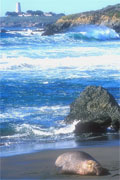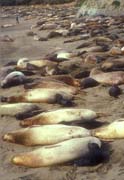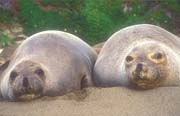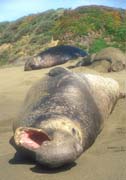ELEPHANT SEALS AT PIEDRAS BLANCAS
Saturday, April 29th, 2006 at 3:02 pm by Ken
January and February, 2006
Hi folks! In January and February I took a couple of three-day trips with friends Skip Stubbs and Phil Colla to Piedras Blancas, CA to visit a rookery of northern elephant seals (Mirounga angustirostris) and observe the annual birthing/breeding season. Piedras Blancas is located about eight miles north of San Simeon, and about five miles north of Hearst Castle.
This was our destination–the beaches just south of the Piedras Blancas Lighthouse. The elephant seals start showing up here in November, and the height of the birthing/fighting/breeding season is in February. Except for short periods during April-August when the females, juveniles, subadult and adult males return at different times to molt, elephant seals spend the rest of their lives in the ocean, ranging as far north as the south coast of Alaska and the Aleutian Islands. The can dive to a depth of one mile (a distance only exceeded among air-breathers by sperm whales) in search of squid and other deep water prey.
Given all the bad news we’re constantly hearing about the environment and the negative impact on our wildlife, elephant seals are a remarkable exception. These animals were slaughtered in the 1800’s for the oil from their blubber. By 1892, only 50-100 individuals were left. In the 1920’s they were protected by Mexico and the U.S. Today, the population has rebounded to approximately 160,000, about 14,000 of which populate almost four miles of the coast at Piedras Blancas. A parking lot and large boardwalk has been built in one section which offers close viewing (although a long zoom lens is recommended).
Births of the black pups start in mid-December, and peak around mid-February. The mother will vocalize, bonding her voice and scent with that of her pup, so they can find each other if separated as the population grows on the beach.
The mothers nurse their pups on fat-rich milk for 28 days. During that time the pup, which weighs about 60lbs at birth, will quadruple its weight. The black coat fades to brown as the pup matures, at which point the pup is called a weaner. The weaner will remain at the rookery for about two months after the mother stops nursing, living off its fat reserves as it learns to swim and forage.
A flock of gulls hovering over the seal colony usually means a birth has occurred, as the birds clean up the afterbirth.
Hard to believe those cute little pups can mature into males that reach 16 feet in length and can weigh 5,000lbs! The females are considerably smaller, but still can reach up to ten feet in length and weigh one ton. Adult males are awesome behemoths, with the long noses that give elephant seals their name.
After her pup is weaned, the female comes into estrus and is ready to mate again. Each alpha-male “beachmaster” has an established territory and may assemble a harem of 30-40 females. The alpha-male expects to breed multiple times with “his” females, and the mating season, which peaks in mid-February, is when the males are often seen fighting. Since the males are too busy breeding and fighting to feed, I guess it’s no wonder they can lose up to 2,000lbs (40% of body weight) during the Nov-Feb period when they are on the beach! Is it just me, or does this female seem to be saying, “Hey! What about foreplay?”
One of the small coves at Piedras Blancas has a “bachelor’s beach” where younger males congregate. Since there are no females, there are also no alpha-males present to chase the young males away. They are often seen practicing the fighting skills they will need to learn in order to carve out their own territory and harem when they are older.
The boardwalk area has a nice background for sunset shots, if you are fortunate enough to get a couple of males arguing in the foreground.
And when you don’t have elephant seals in the foreground of your beach sunset shot, there are always shorebirds. Too bad there wasn’t an oak tree around, or I could have captured the majority of clichéd nature shots at one location…..
That’s it folks! I’m returning to the Bahamas for sharks and dolphins in May, and I promise to be more punctual about my next blog post from that trip!
Best to all,
Ken
www.seaimages.org


















 Permalink
Permalink Filed under:
Filed under: 